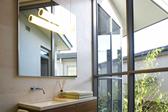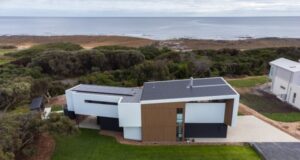
Bathrooms require good task lighting for practicality and safety, but it needs to be designed in such a way as to avoid glare from mirrors.
Choosing the best lighting for your bathroom is important because, like kitchens, these rooms require good task lighting. While being able to see exactly what you’re doing in the bathroom is very important, many bathrooms end up being over-lit and very clinical.
This is why natural light is ideal for a bathroom. A good source of natural light, such as a window or a skylight, can provide a lot of the light needed during the daytime, which will lower your dependency on artificial light sources, and in turn, your power bill. If the window can be opened, it will also provide access to natural ventilation and lower your dependency on exhaust fans.

Bathroom lighting design fundamentals
In order to get the most from your bathroom’s lighting design, you should also consider the following:
- Bright light is necessary in bathrooms, because it can alert you to any water on the floor around showers, basins and bathtubs.
- The sink and mirror should be lit in such a way that faces are lit evenly, without shadows. To accomplish this, more than one light is generally necessary. Try using a row of lighting above the mirror or a light fixture on either side at eye level.
- Recessed lighting placed directly above a mirror can cast harsh shadows across your face, making grooming more difficult.
- All light fixtures should be moisture-proof to a rating of IP67, particularly those used in showers.
- Lights directed toward the ceiling will make the room appear larger.
- The colour of the walls in your bathroom has a dramatic effect on the quality and colour of lighting you end up with. Some paint colours on the wall work perfectly with white-based lighting while others work better with yellow-based lighting, so it’s a good idea to consider colour temperature and paint.
- To get the most natural skin tones reflected in the mirror, use halogen bulbs as they emit a crisp, white light.
- Shower stalls, particularly those that use an opaque or frosted glass, may require extra lighting to compensate for the light that’s lost as a result of the shower screens.
Heat lamps
While tremendously inefficient at producing light, incandescent light bulbs have found a purpose in the modern bathroom as heat lamps. Heat lamps are simply that: lamps that generate heat, not light. This, however, raises a series of problems. The amount of heat generated by a heat lamp can actually melt a plastic light fixture, so if you plan to include one, you should ensure that the socket you use is ceramic. Further, a mesh or ceramic guard should cover the lamp to stop anyone or anything from accidental touching the bulb.
All said and done, the look and feel of a bathroom isn’t more important than your safety. Electricity and water are lethal companions and nowhere do they mingle more closely than in the bathroom. Always consult a certified electrician before tackling even the simplest lighting project in your bathroom.
Waterproofing for lighting
Lighting over a shower will need to be waterproofed. If you are choosing recessed lights such as halogen or LED spotlights, sealed covers are available which will help stop any fixture degradation from steam. Likewise, there are specialised shower lighting solutions available too, including banks of LED lights which can be installed in walls or along the tops of shower screens.
Shower heads with lights in them
There are surprisingly large amounts of shower heads available these days which incorporate LED lighting too. The lights are available in a wide range of colours, and some even have temperature sensors in them which alter the colour of the light to indicate how warm the water is.




